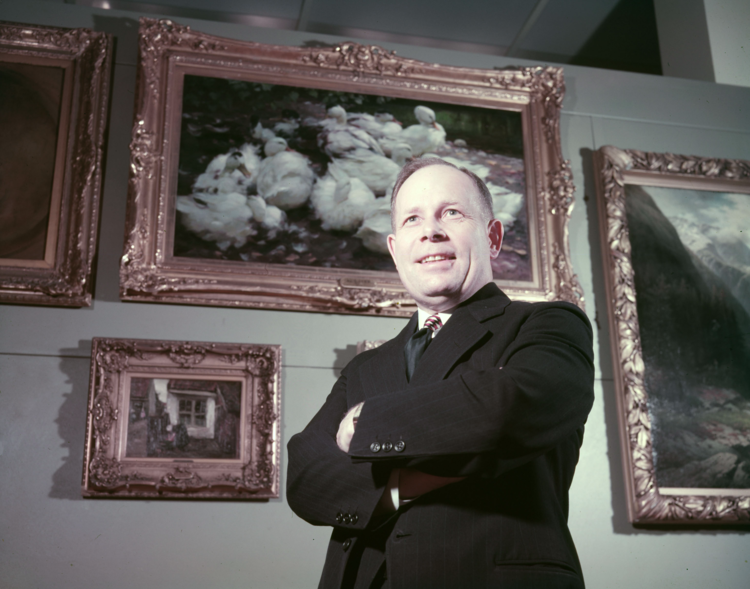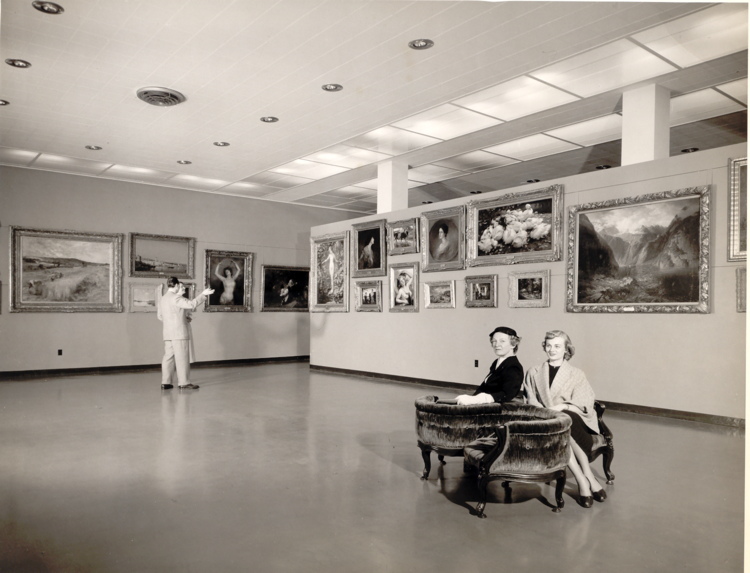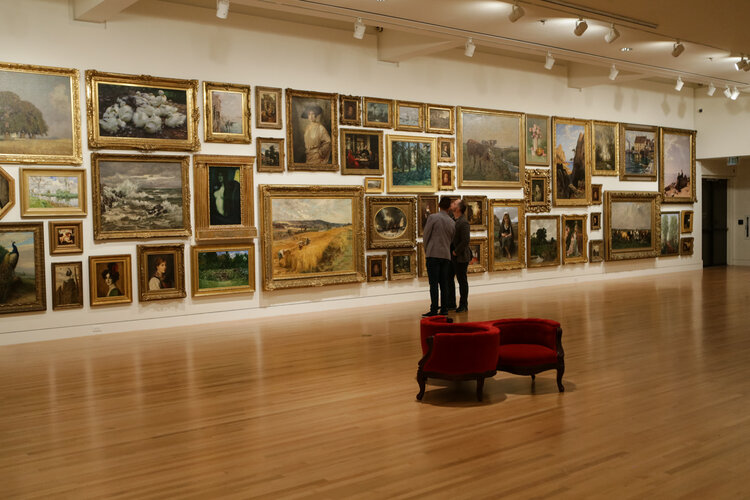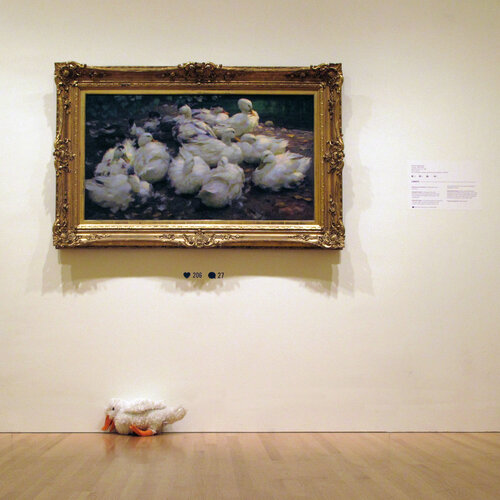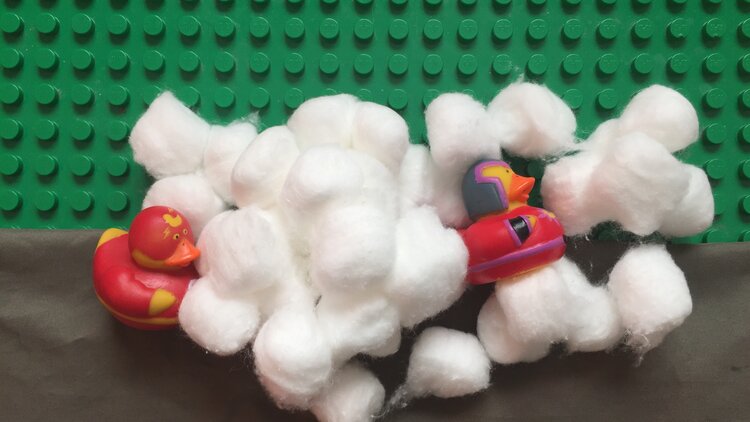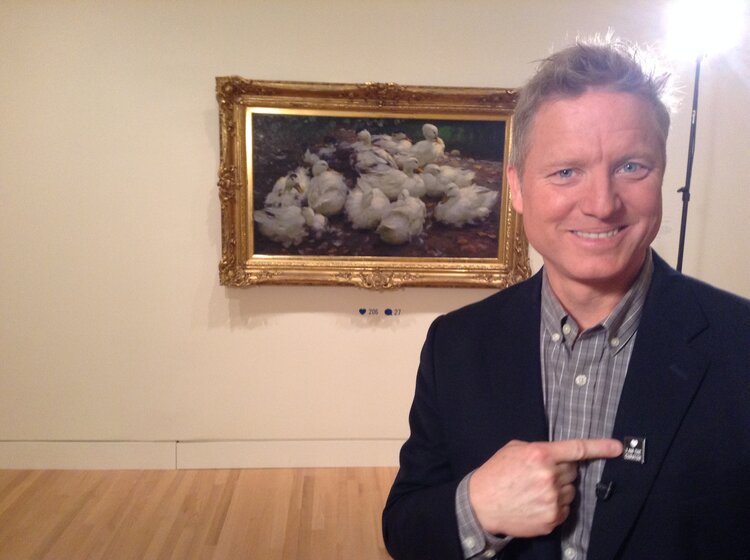Collection Connection is a series of personal responses by Museum staff to works in the Frye Art Museum’s collection.
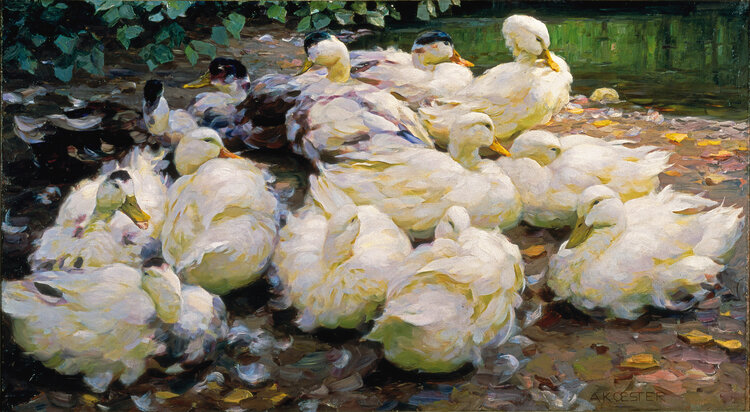
Alexander Max Koester. Moulting Ducks, ca. 1900. Oil on canvas. 18 3/8 x 51 3/8 in. Frye Art Museum, Founding Collection, Gift of Charles and Emma Frye, 1952.087. Photo: Spike Mafford.
Alexander Max Koester’s Moulting Ducks is a staple in the Frye Art Museum’s Founding Collection. Over the years, it has been represented in a number of exhibitions and on postcards and posters, captivating countless visitors. What is it about this image of the familiar waterfowl in a moment of simplistic bliss that generates such enthusiasm? Let’s take a look at what makes this oil painting so beloved. Read on to the end for a special art-making activity inspired by the work!
Alexander Max Koester (1864-1932) was a German painter who specialized in genre, still life, and animal scenes. Formally trained in the traditional Munich and Düsseldorf styles, Koester settled in the Austrian province of Tyrol, and it was here that he discovered his motif of choice, under the chestnut tree beside his studio—the duck.
Koester first exhibited his duck paintings in 1889, and the feedback was so remarkable that he devoted himself solely to this waterfowl for the next thirty years (you can see more of his ducks here). Koester carefully studied his surrounding fauna, capturing the bird in detailed movement, at rest, and in groups. What resulted were meticulously constructed scenes of masterful technique and sensitivity.
Why the duck? An animal described by art scholar Katharina Hegewisch as “harmless, peaceful, and perhaps a little silly,” the duck remains a recognizable and unassuming member of our ecosystem. A quick search on duck symbolism generates a range of possible meanings across cultures, from community to forward-thinking energy.
Moulting Ducks is a beautiful example of Koester’s dedication to his preferred bird, as well as his individual style, which was described by scholars as “conservative in his approach to form, Impressionist in his approach to light and its reflexes.” In this particular painting, we are witness to a loose arrangement of twelve ducks preening their feathers, evident by the whispery shapes settling on the earthen ground. The artist depicts the birds in accurate detail—mid-twist, pluck, and snuggle—creating energy in the composition. Our feathered friends are seemingly unaware of their audience or too occupied to care.
The artist captures the texture and plumage of the birds’ feathers through his impressionistic brushstrokes, making them appear fluffably soft. The color bouncing off the animals’ feathers onto the water in shades of white, yellow, lavender, and peach showcases Koester’s use of color to create light. In contrast, the corners of the painting remain in shadow, made up of deep greens and browns. Might we imagine a storm is on the way?
We contemporary viewers are not alone in our love of Koester’s ducks. The artist’s work was exhibited internationally, with scholars and high society praising the artist’s technical and lively depictions of fowl. The German Emperor Wilhelm II and King Emanuel III of Italy each purchased one of Koester’s duck paintings, and the artist earned a gold medal at the 1904 St. Louis World’s Fair for a similar composition. It is even suggested that the value of one of Koester’s paintings was determined by the number of ducks it featured. Koester’s popularity waned as the public turned away from 19th-century realist art and towards more modern styles, yet the artist’s ducks continue to have impact on viewers, old and new alike.
Moulting Ducks is one of the Frye’s most well-known paintings. It has been a staple for our school tours and was recently featured in an artwork recreation challenge as part of the Museum’s #FryeFromHome social media initiative in response to the global coronavirus lockdowns.
In 2014, Moulting Ducks was featured in #SocialMedium, a crowd-curated exhibition featuring favorites of the Frye’s Founding Collection. Visitor comments were displayed in the galleries, which both aligned with and extended formal praises of Koester’s treasured painting:
-
Meredith: “I will always look at this painting and hear and smell and see those lovely ducks preening and happily clucking away in the dappled light.”
-
Ellesmith: “I like everything about this painting! The artist really captures the eventfulness of the moment, with energy and delicate frenzy in the moulting process. The colors invite us to delight in celebration of a sort.”
-
Daniel: “A dear friend... introduced me to the Frye 30 years ago or more. She brought her children to the museum when they were small and this was their favorite. I think it is beautiful as well and connects me to my friend’s spirit.”
-
Vanessa: “I like big ducks and I cannot lie.” (cue Sir Mix-a-Lot’s “Baby Got Back”)
“The world knows that Koester represents the duck’s character and life with superior skills and in incomparable perfection.”
— Dr. Horazio Gaiger, friend and artist
Alexander Max Koester devoted his career to perfecting his treasured subject and sharing it with an eager audience. Whether it is the gossamer of feathers that look soft enough to sink into, the drenching blend of color and light, or the care of attention granted to such a universal and recognizable animal, we continue to adore Moulting Ducks. And in times of such uncertainty, perhaps the image of a pile of relaxed animals might help connect you with the Frye community, allowing for a moment of respite, familiarity, and beautiful simplicity.
We invite you to create your own origami duck as a way to spark joy in the same way Moulting Ducks has done for so many visitors across the years. Keep your origami duck or share it with a loved one! Tag #FryeFromHome to let us know how your duck turned out.
Caroline Byrd
Education Coordinator
